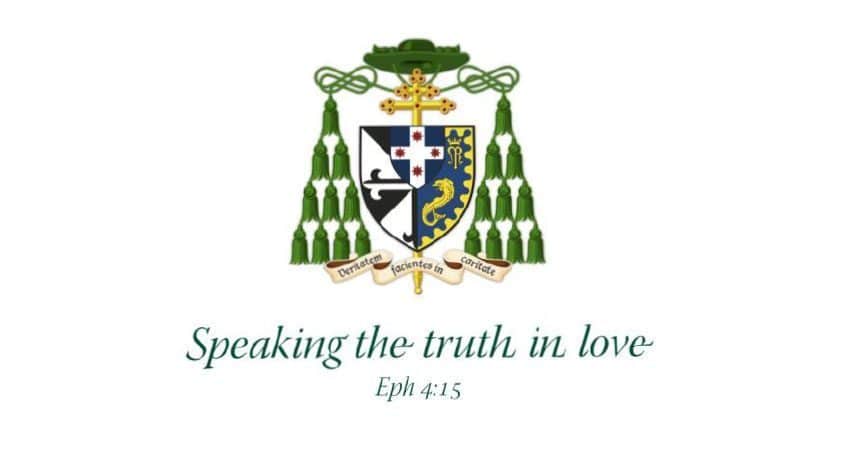HOMILY FOR THE SOLEMN MASS FOR THE SESQUICENTENARY OF MARIST EDUCATION IN AUSTRALIA

St. Mary’s Cathedral, Sydney, 8 April, 2022
One of the best-selling non-fiction books of recent years has been Jordan Peterson’s 12 Rules for Life: An Antidote for Chaos. Since its release in 2018, 12 Rules has sold over 5 million copies world-wide and propelled its author to pop-star status amongst cultural influencers and life coaches. At his sold-out speaking tours thousands of young adults pay pop-concert prices to hear this clinical psychologist and university professor on how to navigate the dramas of life, drawing on philosophical ethics, psychology, mythology, religion and personal anecdote.[i]
In his book Peterson offers twelve rules for living the good life with an essay explaining each. These are:
- Stand up straight with your shoulders back.
- Treat yourself like someone you are responsible for helping.
- Make friends who want the best for you.
- Compare yourself to who you were yesterday, not to who someone else is today.
- Don’t let your children do anything that makes you dislike them.
- Set your house in order before you criticise the world.
- Pursue what’s meaningful, not what’s expedient.
- Tell the truth or, at least, don’t lie.
- Assume that the person you are listening to might know something you don’t.
- Be precise in your speech.
- Don’t bother children when they are skateboarding.
- Pet a cat if you encounter one on the street.
Peterson’s core idea is that hardship is part and parcel of being human and that in a world of chaos (including the mix of light and darkness within us) we have a choice to make: whether to withdraw or to face suffering head-on and hopefully transcend it. Peterson believes the skeleton key to unlocking meaning in our lives when things are hard is accepting personal responsibility: to make it through the chaos, we need to step up, make changes, take control.
Marcellin Champagnat was accustomed to chaos, including the dark and light in the human heart. He was born to a peasant family in 1789, the year of the French revolution. Before his very eyes the Estates-General and feudal order crumbled, there were riots in Paris and mob rule, the monarchy was ended in bloody fashion, civil war cost half a million lives, and wars with most other European nations cost many more. There was the tyrannical Committee of Public Safety, the Napoleonic coup, further revolutions and counter-revolutions, republics and restorations, and much use of the guillotine all around. The Church faced the confiscation of all its property, a schism between state-sworn clergy and the rest, disconnection from the papacy, anti-clerical feeling, and the near extinction of religious life.
So how did our illiterate farm-boy, at one point a member of a group of pub-crawling, boisterous seminarians known as the “Happy Gang”, go on to lead a movement that would impact the education of so many young people around the world for centuries to come? What drove him to see that proclaiming the Word of God to the young and reminding them of God’s all-encompassing love, was worth giving his life to? Well, it’s said that “Behind every successful man there is a woman” and that’s certainly a crucial part of the story of Marcellin Champagnat!
Marcellin’s devotion to our Blessed Mother went back at least to his time in St Irenaeus Seminary in Lyon. A city well known for its Marian piety, the famous golden Virgin looks over it from the Basilica of Notre Dame du Fourvière. In a bid to reverse the collapse of religious life after the Revolution, a day after he was ordained a priest, Marcellin and a handful of friends dedicated themselves to the Blessed Mother in that very sanctuary, and founded the Society of Mary.[ii] The Order was destined to serve not only the recovery of the Church in France but also the French Church’s great mission to the South Pacific and beyond.
A subsequent fateful encounter with a dying 17-year-old who knew almost nothing of the Christian faith impressed upon Marcellin the urgency of doing something about the mission to young people.[iii] Another momentous experience—nearly dying in a blizzard and being saved by a farmer after praying the Memorare—reassured him that the Blessed Mother would protect him and his evangelical-educational project.[iv] And so, despite considerable resistance, Marcellin established a distinct branch of teaching brothers, the Petits Frères de Marie (The Little Brothers of Mary).[v] Since it was his bright idea, he was saddled with leading them, even though he had no experience of schools or religious brothers! What he lacked in technical expertise for system leadership, Marcellin made up for in spades with inspiration: the aim of his brothers would be to make Jesus Christ and his Church known to and loved by the young, and especially the most neglected, through devotion to and intercession of Mary.
Marcellin was convinced that for his teaching Brothers to flourish they must embody and live out the ideals of the best of teachers, the one who taught the child Jesus himself, Mother Mary. The prophets of the French revolution had blasphemously erected a statue of the goddess Reason in the Cathedral of Notre Dame in Strasbourg, making liberté, égalité and fraternité the new untheological virtues. Marcellin proposed that his fraternity might learn instead three virtues of simplicity, humility and discretion, Marian qualities that would help bring the young to the knowledge and love of God. Like Peterson today telling the young to tidy their room, straighten their backs and take responsibility, Marcellin offered his own “12 rules”:
- Readily forebear, minimise or pardon other people’s offences
- Conceal your displeasure with their mistakes
- Compassionately relieve or help bear another’s sufferings
- Magnify what is joyful in their lives
- Instead of imposing your opinions on others try to learn from them
- Anticipate other people’s needs and respond without them needing to ask
- Listen, instruct and assist with patience and charm, even those who are unreasonable
- Show everyone signs of respect, consideration and deference
- Readily adapt to other people’s wishes, including both superiors and subordinates
- Prefer the common good to your own interests
- Endure without complaining and persevere in doing good even to the ungrateful
- Be gentle, affable and even-tempered, even in situations that evoke impatience, boredom, depression or anger.
By laying such solid and practical foundations even amidst the chaos of the French revolutionary era, Marcellin set up his fraternity to grow from a handful of brothers teaching in a small rural school in 1818, to now a major religious order educating and forming over half a million young people across 82 countries world-wide, including 50,000 in our own country. Together we see the fulfilment of Isaiah’s vision in our first reading of a joyful house of prayer where people of every nation and kind are welcomed, taught integrity and justice, and attached to God and the things of God (Isa 56:1,6-7).
But if his life tells us anything, Marcellin would most assuredly take no credit for this. He would say that it was all God’s grace and Mary’s intercession, and that he was doing no more than fulfilling the great commission in today’s Gospel, to proclaim the Good News to the whole world, to tell all people of Christ and his boundless love (Mk 16:15-20).
All to Jesus through Mary; All to Mary for Jesus!Happy birthday, Marist education in Australia! Ad multos annos!
[i] Why young people are turning to Jordan Peterson | Angelus News
[ii] Constitutions_and_Statutes_Marist_Brothers_October2020.pdf (champagnat.org), 15.
[iii] Sean Sammon, A Heart that Knows No Bounds: Saint Marcellin Champagnat, The Life and Mission, Champagnat_Sean_HeartNoBounds_en.pdf, p. 32.
[iv] Sammon, p. 44.
[v] Sammon, 19-22.
INTRODUCTION TO THE SOLEMN MASS FOR THE SESQUICENTENARY OF MARIST EDUCATION IN AUSTRALIA
St. Mary’s Cathedral, Sydney, 8 April, 2022
Welcome to St. Mary’s Cathedral in Sydney for this Solemn Mass of celebration for the sesquicentenary of Marist education in Australia. On this day 150 years ago, four Marist brothers in their 20s, commenced the first Marist school in Australia down the road from here in the Rocks, nearby where the Marist Fathers were already ensconced. They were French Brother Ludovic (Pierre Laboureyras, aged 29) the principal; Irish Brother Jarlath (Thomas Finand, aged 25) his assistant; Scots Brother Augustinus (Donald McDonald, aged 21) teacher of grade 6; and Irish Brother Peter (Patrick Tennyson, aged 25) the cook. After the 7AM Mass parents queued to enrol the first 139 boys in St Patrick’s Boys’ School. 150 years and hundreds of Marist Brothers and their lay associates later, Marist Schools Australia now have care of over fifty thousand students across nineteen dioceses. St Marcellin Champagnat’s spirituality, focused on Jesus and the Church through Mary our Good Mother, has brought many young people to the knowledge and love of God.
From the Marist Brothers Province of Australia, I welcome: Provincial, Br. Peter Carroll FMS; Vice Provincial, Br. Darren Burge FMS; Senior Marist Brothers and famous educators, Br Jeff Crowe FMS; Br. John Thompson FMS; Br. Kelvin Canavan FMS; Br. Michael Green FMS; Br. Robert O’Connor FMS; Br. David Hall FMS; and the more than forty other Marist Brothers in attendance.
I acknowledge concelebrating with me this evening several episcopal and priestly old-boys of Marist schools: Archbishop Peter Comensoli of Melbourne; Bishop Vincent Long OFMConv of Parramatta; Bishop Mark Edwards OMI of Wagga Wagga, a member of the National Catholic Education Commission; Auxiliary Bishop of Sydney Terry Brady; the Provincial of the Marist Fathers Australian province, Very Rev. Fr Tony Corcoran SM; and many other brother priests.
In attendance today I also acknowledge the State member for Maroubra, Mr Michael Daley MLA; the National Director of Marist Schools Australia, Mr Frank Malloy; Executive Director of the National Catholic Education Commission, Hon. Jacinta Collins; the Directors of Education of the Brisbane, Dr Doug Ashleigh; of Cairns, Mr Bill Dixon; of Wagga Wagga, Mr Andrew Watson; of Canberra and Goulburn, Mr Ross Fox; and of Wollongong, Mr Peter Hill; as well as the Director of RE and Evangelisation for Sydney Catholic Schools, Mr Anthony Cleary, and representatives of other education authorities.
To the student and staff representatives of the 56 Marist schools and all those associated with those schools in the past or present: a very warm welcome to you all.

